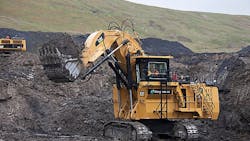Caterpillar Revenue Leaps 24.6 Percent in Third Quarter
Caterpillar reported third-quarter sales and revenues of $11.413 billion compared to $9.16 billion in the third quarter of 2016, a 24.6-percent year-over-year increase, with the largest jump in North America. Profit per share was $1.77 compared with $0.48 per share in the same quarter a year ago.
Caterpillar’s financial position strengthened during the quarter. Machinery, Energy & Transportation’s operating cash flow was about $600 million during the third quarter, and its debt-to-capital ratio improved to 36.1 percent, down from 38.6 percent at the end of the second quarter. Caterpillar ended the third quarter of 2017 with an enterprise cash balance of $9.6 billion.
“Higher sales volume and our team’s focus on cost discipline resulted in improved profit margins across our three primary segments,” said Caterpillar CEO Jim Umpleby.
Caterpillar continues to see strength in a number of industries and regions, including construction in China, onshore oil and gas in North America, and increased capital investments by mining customers. In July 2017, Caterpillar provided an outlook range for full-year 2017 sales and revenues of $42 billion to $44 billion, with a midpoint of $43 billion. The company is now expecting full-year 2017 sales and revenues of about $44 billion.
“As a result of our team’s strong performance, we are raising our 2017 profit outlook,” said Umpleby. “We are executing our new strategy for profitable growth based on operational excellence, expanded offerings and services.”
Caterpillar said its third quarter increase was primarily the result of higher sales volume, from improved end user demand and favorable changes in end-user inventories. The improvement in end user demand was across all regions and most end markets. The favorable change in dealer inventories was primarily because of a decrease during the third quarter of 2016.
The largest sales volume increase was in Construction Industries. Sales increased across all regions with the largest increase in North America. Sales improved 27 percent in North America because of higher end user demand for both equipment and after-market parts, as well as favorable changes in dealer inventories. Asia Pacific sales jumped 31 percent, primarily because of higher end user demand for construction equipment, with about half of the sales improvement being in China.
Europe, Middle East and Africa sales hiked 22 percent, and 24 percent in Latin America where stabilizing economic conditions in several countries resulted in improved end user demand.
Favorable price realization contributed to increased sales in North America. Also end user demand for construction equipment increased primarily because of improved oil and gas, residential and nonresidential construction activities. Sales increased in the power generation segment because of the timing of projects.
About the Author
Michael Roth
Editor
Michael Roth has covered the equipment rental industry full time for RER since 1989 and has served as the magazine’s editor in chief since 1994. He has nearly 30 years experience as a professional journalist. Roth has visited hundreds of rental centers and industry manufacturers, written hundreds of feature stories for RER and thousands of news stories for the magazine and its electronic newsletter RER Reports. Roth has interviewed leading executives for most of the industry’s largest rental companies and manufacturers as well as hundreds of smaller independent companies. He has visited with and reported on rental companies and manufacturers in Europe, Central America and Asia as well as Mexico, Canada and the United States. Roth was co-founder of RER Reports, the industry’s first weekly newsletter, which began as a fax newsletter in 1996, and later became an online newsletter. Roth has spoken at conventions sponsored by the American Rental Association, Associated Equipment Distributors, California Rental Association and other industry events and has spoken before industry groups in several countries. He lives and works in Los Angeles when he’s not traveling to cover industry events.
